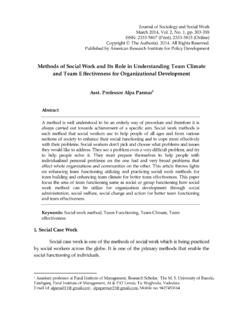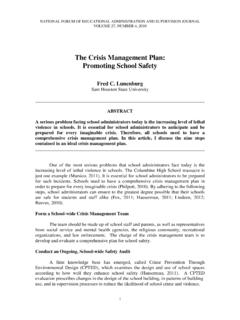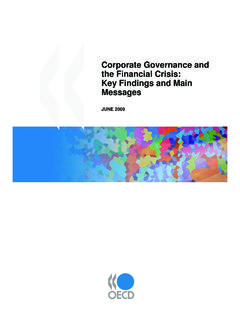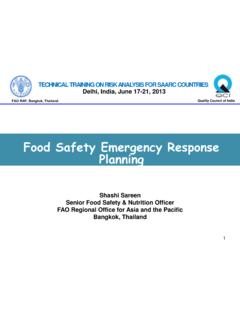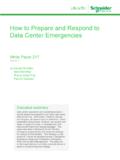Transcription of Examine the Role of Social Workers in Crisis Management
1 Journal of Sociology and Social Work March 2014, Vol. 2, No. 1, pp. 87-97 ISSN: 2333-5807 (Print), 2333-5815 (Online) Copyright The Author(s). 2014. All Rights Reserved. Published by American Research Institute for Policy Development Examine the Role of Social Workers in Crisis Management Dr. Mohammad Reza Iravani1 and Sajjad Majidi Parast2 Abstract Pressure, creating a psychological Crisis - particularly the large communities, which will cause the breakdown of the conventional ideas of life and Social interactions and financial and human injuries, threats, risks, and that, creates new needs. According to "Pearson" and "Claire", includes Crisis Management , systematic efforts by members with stakeholders outside the organization, in order to prevent or manage crises and its impact on time Social work teams, Crisis Management to deal with emergency situations form, are similar. These groups are likely to affect the type of Crisis , the experts will have numerous and diverse.
2 This study examines the role of Social Workers , the urban Crisis Management during a Crisis , has the responsibility of Social Workers has direct control over them. Keywords: Crisis Management , Social Workers , planning Introduction Of environmental change on human life, individual and collective human form is undeniable role in the progress of human history. Human societies throughout history have been larger and more complex, so that now controls large cities with populations of one million are in different parts of the world. Current metropolises contains a huge amount of people, structures, transportation, natural and economic resources are gathered the most complex human-made systems and with chains of different operations, the impact of local, regional, national, regional and international power to generate wealth and pay. 1 Assistant Professor, Department of Social Work, Islamic Azad University Khomeinishahr Branch, Daneshjou Blvd, Iran.
3 Of Social Work, Allameh Tabatabali Univrsity, Terhran, Iran. 88 Journal of Sociology and Social Work, Vol. 2(1), March 2014 The problems of these societies have become more complex with its complexity; So that a significant proportion of public resources spent on preventing these problems and reduce complications that can occur. Ultra modernist of our environment with such an increase in population, urbanization, growing reliance on technology; Political, economic, cultural encounter, the world has become distressed.(Gholipour,2004) Increasing population density in urban areas and the disproportionate distribution of urban facilities, the community's vulnerability to Crisis has sparked.(Hosseini,2004) Crisis in terms of speed and in terms of the occurrence of two types of sudden and gradual, and the natural and man are divided into two categories :( UNDP,2002:335) The prevention of crises and catastrophes, the best way to prevent it, although the occurrence of disasters such as earthquakes cannot be prevented; Predictable crises, the best method at an early stage, to prevent a disaster after disaster.
4 The second step is a full-fledged campaign outreach and coordination of resources through careful planning and efficient mobilization of forces, Practice being alert forces and for no foreseeable accidents are preventable. Third step when faced with a disaster, it is a prerequisite to suit the speed of disaster situations. At this stage, the prevention of waste and limit the spread of Crisis is important. The fourth step, preventing enduring Crisis and its effects. In other words, at this stage, the speed must be compensated for damages not caused the Crisis and finally, the fifth step, the normalization of the situation comes to normal routines the area rule.(Aghabakhshi,2003:134) Crisis Management First of all, it is better to separately deal with the Crisis Management concept and then so that we can put on the general definition of Crisis Management . The idea, the art of managing the affairs of others and accepted by others and describe the purpose of them is emphasized.
5 Iravani & Parast 89 Another group in the form of Management tasks such as planning, organizing, coordinating, and have expressed. Some have described it as a manager that can manage and coordinate the science and art of leadership and control of group activities, to achieve the desired goals, with declared maximum performance. The Management of some of the most desirable use of available resources (human resources - financial resources and physical facilities) or by applying the principles of Management (planning, organizing, directing, leadership, control, and coordination) has been defined to achieve specific purpose the Crisis is generally unpredictable (means you cannot predict when and where that happens). Impact of crises and people who needed help were before the Crisis , as the Crisis will be helped; Nature and effects are long and amortization; The decision usually under extreme situation, and the limited time and information needed for decision-makers is incomplete; The time limit for responding to the transfer decision, and the decision unit members are shocked and amazed; Compression and time constraints, surprise, stress and distortion of information.
6 (Wilson,1992) Now we can summarize the information provided Crisis Management defined: Adventure naturally or by human, and suddenly there is a growing and hardship to the human society in a way to impose order on the other hand needs to be super critical activities; Also, According to "Pearson" and "Claire", includes Crisis Management , Systematic effort by members of the organization with stakeholders outside the organization, In order to prevent or manage crises effectively, which, in the event of a Crisis Management team to deal with situations of extreme Social form. The Main Goals of Crisis Management Save lives Reduce the number of victims Reduce damage to property, assets and the environment Depending on the application is better, before addressing the critical location features and introducing systematic approach in order to deal effectively be noted that however, there is a system in Crisis , either directly, or external factors have hampered the system.
7 In both cases, we analyze their observations systematically advance; because the Crisis Management task, effective decision making based on accurate information in order to reduce the damage control and Crisis . 90 Journal of Sociology and Social Work, Vol. 2(1), March 2014 The process of identifying the actions and reactions are carried out systematically. Otherwise, decisions will be nothing but trial and error, and with respect to three factors, time constraints, threats and surprises cannot be expected to be room for such an approach. New Perspective on of Crisis Management New perspective on of Crisis Management , relief and rescue the only stage of the cycle (cycle) knows catastrophes, new perspective on disaster Management , relief and rescue problem only knows, the stage of the cycle disasters, Crisis Management is a new perspective on the old belief believe that "there must be cured before the event.
8 " And never sat passively waiting for the disasters, but also to help knowledge, Knowledge and technology to battle went public awareness and community mobilization tools necessary human and material losses caused by injuries to minimize sudden disasters. Pre-disaster Crisis Management procedures typically begin to normalize and rebuild the damaged ends. Research issues related to unexpected disasters, usually between two points or a stage or parts of several steps, which are more or less the same. For example, M. F. Lechat, the process consists of five steps as each disaster and takes such steps outlined: Stage of expectations or predictions (Anticipipative Phase) Alarm Phase Rescue Phase Stage of release and relief of suffering and the normalization (Relief Phase) Step Reconstruction and Rehabilitation (Rehabilitation) (Lechat, 1990: 3) New perspective on Crisis Management , the traditional view, the expected or anticipated step as the most important step.
9 While the traditional view of the rescue and relief insists. Expected or projected on stage, it is important that the four important concepts and irreplaceable, the identification, planning, prevention and preparedness has been formed. Every society needs its catastrophes and various well know and with review of past and through careful research and knowing the types of disasters, the shape and magnitude to those observed. In this formulation phase of the disaster plan and scope of its location, as well as the likelihood and severity within national boundaries, is considered the most important step. Iravani & Parast 91 For example, all are aware that earthquakes, ground movement, landslides and floods are the most important and most common disasters that have occurred in every so often fall victim.
10 Providing and characterizing such risk maps at different locations, regional characteristics of disasters in terms of population and places, risk can be formulated recipes and tools necessary to make informed approach to these areas was submitted. After identification, planning stage begins. Program combat the disasters and crises, the long-term program of development of the country is indivisible, For example, flood prevention with flood make necessary practical and construction of dams and flooding of agricultural development is also essential, Die and becoming homeless, the influx of contemporary indicators of economic and Social backwardness. Because of late such matters are largely in the control of human and instead of destruction, bring prosperity, and more products. But in planning the fight against earthquakes, there is a difference. There is no ability to predict earthquakes; than months or days ago; Apart from the preparing and dealing with earthquake retrofitting city and the countryside, the construction was not feasible.
